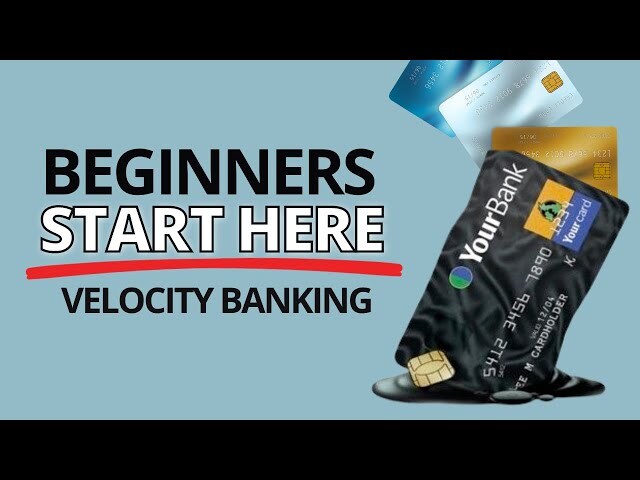In the world of personal finance, velocity banking has become increasingly popular among homeowners looking to manage debt and build wealth. But is it the right fit for your long-term financial goals?
Velocity banking is essentially using a low-interest loan to pay off higher-interest debt, taking advantage of interest rates and simple interest calculations.
However, it’s important to recognize the risks involved with taking on more debt to pay off existing debt. This approach may not be suitable for everyone.
Let’s take a closer look at what velocity banking entails, how you can get started with it, and the pros and cons. We’ll also discuss alternative strategies for managing your finances if Velocity banking isn’t the right choice for you.
What Is Velocity Banking?
Velocity Banking is a method for paying off debt faster by using revolving lines of credit, like credit cards or Home Equity Lines of Credit (HELOCs). It involves smartly using debt to maximize cash flow and pay back high-interest debt quicker through big lump sum payments.
With this approach, making large lump sum payments using lines of credit can help you pay off debt faster and save on interest in the long run. Some people even say you could pay off your mortgage in just 6 years!
Velocity banking works best for debts that have a fixed schedule for paying interest upfront. This means that by making large lump sum payments, you can cut down on the debt faster by reducing the amount you owe. This, in turn, lowers the overall interest you’ll pay over time.
While many people use velocity banking to pay off their mortgage, it can also be handy for tackling other debts, like student loans or credit card bills. And because credit cards often have high-interest rates, using velocity banking with them could be a smart move.
What is HELOC?
A Home Equity Line of Credit (HELOC) serves as a convenient way to manage expenses, functioning as a primary spending account rather than relying solely on a checking account. For individuals with savings, utilizing a HELOC can streamline financial management by directing income towards mortgage payments.
The main objective of this approach is to expedite mortgage repayment, reducing interest costs and shortening the payoff period. Those who use the velocity banking strategy often opt for a HELOC. With a HELOC, homeowners can borrow against the equity in their property, using the house as collateral for the credit line. As the outstanding balance is repaid, the available credit replenishes, similar to how a credit card works.
How Does Velocity Banking Work?
Let’s say you have a home equity line of credit (HELOC) for $20,000. Here’s how velocity banking might work to pay down your mortgage with this HELOC:
- Reduce Mortgage with HELOC: Begin by using the entire $20,000 from your HELOC to make a one-time payment towards your mortgage. This lowers your mortgage balance but creates HELOC debt.
- HELOC as Your Checking Account: Think of your HELOC like a checking account. Deposit your whole paycheck into the HELOC, directing all your income to pay it down.
- Credit Card for Monthly Bills: Use a credit card to cover your everyday expenses throughout the month.
- Consolidate and Repeat: Once a month, use your HELOC to pay off your credit card balance and your regular mortgage payment.
- Positive Cash Flow Pays Down Debt: The key here is having more money coming in than going out. By putting all your income towards the HELOC, you ensure you’re constantly reducing its balance.
- Repeat and Reduce: Once the HELOC balance reaches zero, repeat step 1 with another $20,000 payment on your mortgage. This cycle continues until your mortgage is paid off.
The Outcome: Over time, your mortgage will be gone, leaving only the HELOC balance. By continuing to make payments, you’ll eventually own your home free and clear.
Advantages and Disadvantages of Velocity Banking
Advantages
There are a few key reasons why using the velocity banking method can be beneficial.
First, making larger “chunk” payments helps you pay off your mortgage principal faster. This changes how your monthly mortgage payments are split between paying off the loan and paying interest.
Second, the way HELOC payments are calculated means that as you pay down the balance, you’ll pay less interest. Using a credit card for daily expenses delays when you have to pay, so your money stays in the HELOC longer, reducing the interest you’ll owe.
And finally, velocity banking keeps you focused on paying off your mortgage. It can be hard to stay motivated when paying off debt, but with velocity banking, you’re constantly aware of what you owe and committed to paying it off.
Disadvantages
Velocity banking might seem appealing at first glance, but it’s crucial to understand its potential downsides before fully embracing this method.
- Not Suitable for Everyone:
This strategy isn’t suitable for everyone. It requires having home equity, good credit, and a positive cash flow. If these prerequisites aren’t met, velocity banking may not be feasible. - Complexity and Long-term Commitment:
Mastering velocity banking can be challenging and time-consuming. Understanding the intricacies of the strategy and implementing it effectively demand a considerable effort. Moreover, complex financial strategies often yield limited success for the average individual. - Potential for Increased Debt:
Using a Home Equity Line of Credit (HELOC) can tempt individuals to accumulate more debt. Making unwise financial decisions or facing unforeseen expenses could impede progress or worsen financial situations. - Demanding Discipline:
Sticking to the velocity banking strategy amidst life’s uncertainties demands considerable discipline and self-control. - Narrowed Focus on Mortgage Payoff:
Velocity banking prioritizes paying off mortgages over other financial goals. While reducing mortgage debt is advantageous, neglecting savings and investments may hinder long-term financial stability. - Variable Interest Rates:
HELOCs typically come with variable interest rates, making borrowers vulnerable to fluctuations in borrowing costs. Rising interest rates can prolong debt repayment and increase overall expenses, posing financial risks. - Optimistic Projections:
Online models and examples often present idealized scenarios that may not align with real-life circumstances. Unforeseen events can disrupt planned outcomes, highlighting the disparity between projections and reality. - Potential for Scams:
Be cautious of fraudulent schemes promising assistance or software to implement velocity banking. Paying for unnecessary services can result in financial losses, as velocity banking doesn’t require external aid for execution.
Understanding these considerations allows individuals to make informed decisions about the suitability and implementation of velocity banking in their financial strategy.
Does Velocity Banking Strategy Work?
We’ve learned about velocity banking and seen it in action. Now, let’s see if it fits your financial plans.
Think about these things before you jump in:
- Extra Cash: The more spare cash you have each month, the quicker velocity banking helps you pay off your mortgage. If you only have a little extra, it might not be a big difference and could be more trouble than it’s worth.
- Long-Term Plans: Being debt-free is great, but is paying off your mortgage the best use of your money right now? Sometimes investing your extra cash can grow it faster than the low interest rate you’re probably paying on your mortgage.
- HELOC Interest: HELOCs usually charge a higher interest rate than your mortgage. This higher cost can affect how well velocity banking works for you.
- HELOC Rate Changes: Most HELOCs have rates that can go up, which can mess with your payoff timeline.
- HELOC Fees: Think about any other costs that come with the HELOC.
- Refinancing Instead: Sometimes refinancing your mortgage to a lower rate can save you money just like velocity banking, and you’d still have some cash left over for emergencies or investing.
- Emergency Funds: If you use your HELOC as an emergency fund, velocity banking could leave you short if something unexpected happens.
Velocity Banking Alternatives
If velocity banking doesn’t align with your financial goals, there are other strategies worth considering. Take a look at some alternatives to the velocity banking concept:
-
Payment Schedule:
Consider switching from monthly to biweekly payments. This means making payments every two weeks, resulting in 26 payments per year instead of the usual 12. Over time, this could help you pay off your mortgage a bit faster (assuming this is the goal), though the difference might not be huge.
-
Refinancing:
If possible, look into refinancing your mortgage to get a lower interest rate or a shorter loan term. Refinancing could save you money in the long run and help you pay off your home sooner.
-
Extra Payments:
Making additional payments towards your mortgage principal can make a big difference in the long run. Even if it’s just a little extra each month, it can help reduce your overall debt and save on interest.
-
On-Time Payments:
Make sure to always pay your mortgage on time. By staying on track with payments and managing your finances well, you can free up money for other financial goals like investing or saving.
Closing Thoughts
While velocity banking offers a potential path to quicker mortgage payoff, it’s a complex strategy with strict requirements and demands unwavering discipline. It might be a good fit for people who are very organized and highly motivated to pay off their mortgage quickly.
If you’re unsure about the best course of action, consulting a financial professional can help you evaluate your options and choose the strategy that best aligns with your financial goals and risk tolerance.
Tired of researching Velocity Banking on your own? Let our experts guide you. Get in touch today!
Need Help with Velocity Banking?
Frequently Asked Questions (FAQs)
Can anyone use Velocity Banking?
Not necessarily. Velocity banking relies various types of lines of credit to function. You’ll need home equity and may need to qualify for some lines of credit to participate.
Will Velocity Banking work for all types of debt?
It’s primarily designed to pay down mortgages faster. While some use it for other debts, it’s not universally recommended.
Is Velocity Banking risk-free?
No. It involves using debt (lines of credit) to pay off other debt. Interest rates on lines of credit can be variable, and there’s a risk of owing more than your home’s value in the case of a HELOC.
Who will benefit most?
Those with strong financial discipline, a low-interest HELOC, and a goal to pay off their mortgage early might benefit.
Can you use a credit card?
The strategy typically uses an open ended line of credit like a HELOC as your main account, buy yes a credit card can be used.
Is it the same as infinite banking?
No. Infinite banking uses cash value life insurance, while velocity banking uses a HELOC.
Is velocity banking a good idea?
There are potential benefits, but also significant risks. It’s wise to consult a financial professional before implementing it.
Got More Questions?

My goal is to assist clients/investors in their quest for financial freedom and creating generational wealth through one on one consultation and an abundance of online tools to educate. For the past 5 years I have been a private pension plan consultant with Self Directed Retirement Plans working directly with my partner Rick Pendykoski (owner) or you can .




